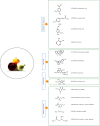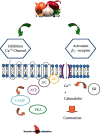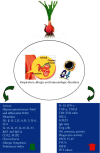Effects of Allium cepa and Its Constituents on Respiratory and Allergic Disorders: A Comprehensive Review of Experimental and Clinical Evidence
- PMID: 34552650
- PMCID: PMC8452398
- DOI: 10.1155/2021/5554259
Effects of Allium cepa and Its Constituents on Respiratory and Allergic Disorders: A Comprehensive Review of Experimental and Clinical Evidence
Abstract
The health benefits of Allium cepa (A. cepa) have been proclaimed for centuries. Various pharmacological and therapeutic effects on respiratory, allergic, and immunologic disorders are shown by A. cepa and its constituents. Flavonoids such as quercetin and kaempferol, alk(en)yl cysteine sulfoxides including S-methyl cysteine sulfoxide and S-propyl cysteine sulfoxide, cycloalliin, thiosulfinates, and sulfides are the main compounds of the plant. A. cepa displays broad-spectrum pharmacological activities including antioxidant, anti-inflammatory, antihypertensive, and antidiabetic effects. Our objective in this review is to present the effects of A. cepa and its constituents on respiratory, allergic, and immunologic disorders. Different online databases were searched to find articles related to the effect of A. cepa extracts and its constituents on respiratory, allergic, and immunologic disorders until the end of December 2020 using keywords such as onion, A. cepa, constituents of A. cepa, therapeutic effects and pharmacological effects, and respiratory, allergic, and immunologic disorders. Extracts and constituents of A. cepa showed tracheal smooth muscle relaxant effects, indicating possible bronchodilator activities or relieving effects on obstructive respiratory diseases. In experimental animal models of different respiratory diseases, the preventive effect of various extracts and constituents of A. cepa was induced by their antioxidant, immunomodulatory, and anti-inflammatory effects. The preventive effects of the plant and its components on lung disorders induced by exposure to noxious agents as well as lung cancer, lung infection, and allergic and immunologic disorders were also indicated in the experimental and clinical studies. Therefore, this review may be considered a scientific basis for development of therapies using this plant, to improve respiratory, allergic, and immunologic disorders.
Copyright © 2021 Sima Beigoli et al.
Conflict of interest statement
The authors declare no conflicts of interest.
Figures




References
-
- Gharirvand Eskandari E., Setorki M., Doudi M. Medicinal plants with antileishmanial properties: a review study. Pharmaceutical and Biomedical Research . 2020;6(1):1–16. doi: 10.18502/pbr.v6i1.3422. - DOI
-
- Ebhomielen J., Azeke M. The effects of sprouting on the antioxidant potentials of onions (Allium cepa L.) 2020.
-
- Nasri S., Anoush M., Khatami N. Evaluation of analgesic and anti-inflammatory effects of fresh onion juice in experimental animals. African Journal of Pharmacy and Pharmacology . 2012;6(23):1679–1684. doi: 10.5897/ajpp12.179. - DOI
Publication types
LinkOut - more resources
Full Text Sources
Research Materials

